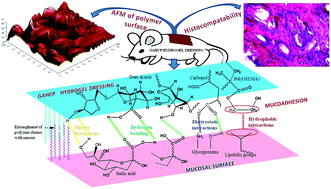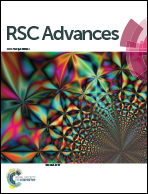Designing bio-mimetic moxifloxacin loaded hydrogel wound dressing to improve antioxidant and pharmacology properties
Abstract
Recently, it has been found that moxifloxacin, an antibiotic drug, promotes wound healing without induction to bacterial resistance. Therefore, it has been incorporated into 2-hydroxyethylmethacrylate (HEMA) based hydrogel wound dressings, for its slow delivery and to enhance its wound curing potential, beside minimizing the adverse effects of systemic drug delivery. These polymer films were characterized by FTIR, solid state 13C NMR, SEM, AFM, XRD, TGA/DTA/DTG, DSC, and swelling measurements. Some important properties of the hydrogel wound dressings like wound fluid absorption, mechanical strength, permeability to O2, H2O vapour and microbes, blood compatibility, protein adsorption, antioxidant activity, ex-vivo mucoadhesion, in-vitro drug release and wound healing potential on an animal model have also been studied in the present work. These hydrogel dressings have taken 7.22 ± 0.26 g wound fluid per gram of gel and showed haemolytic potential of 0.95% and a water vapour transmission rate of 348.57 g per m2 per day. The release of moxifloxacin occurred through a non Fickian diffusion mechanism. The histological studies have revealed effective healing both in the case of wounds treated with drug loaded and unloaded hydrogel wound dressings, which has been proved by the absence of inflammation, matured fibrous tissues, well organised fibroblasts, and blood capillaries. Antioxidant assays showed the free radical scavenging ability of the hydrogel dressings. A correlation, between surface roughness and mucoadhesion, has been established. Overall, these dressings will not only enhance the wound curing process but also take care of the other aspects of wound health and skin regeneration.


 Please wait while we load your content...
Please wait while we load your content...